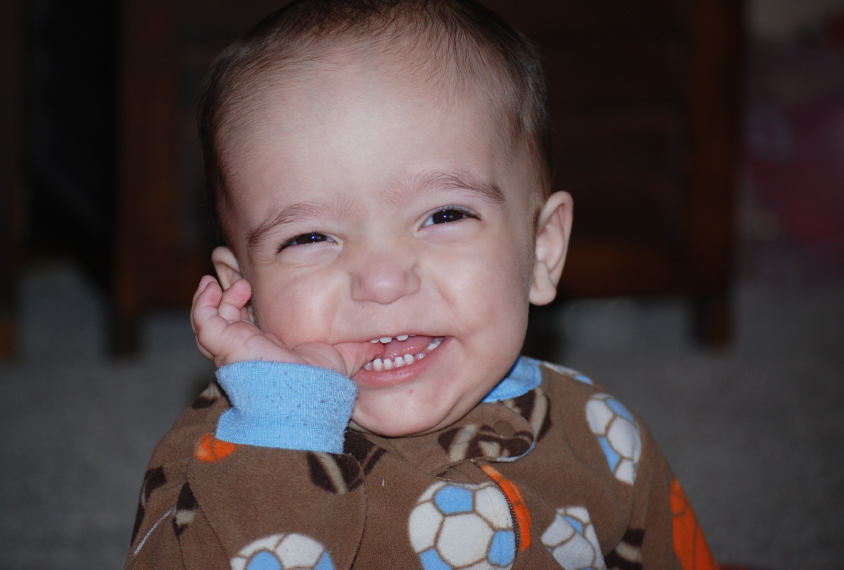Late Teeth in Baby a Sign of Autism

Telltale teeth: Tony, who has an ADNP mutation, had 16 teeth when he was 13 months old.
Courtesty of Sandra Sermone
It was clear from nascency that Tony Sermone was non well: He had heart bug and developmental delay, and would later on be diagnosed with autism. Tony had all the earmarks of a genetic syndrome, but doctors could not figure out which one.
I by one, the tests looked for genetic mutations, some more once — and one by one, the tests came back negative.
Frustrated, Sandra Bedrosian-Sermone, Tony'southward female parent, took him to Knuckles University in Durham, North Carolina, nearly 3,000 miles from their home in Washington. Researchers in that location sequenced all of Tony's genes, looking for mutations he had non inherited from his parents. They found a mutation in ADNP, one of the top candidate genes for autism.
Information technology took six years for Bedrosian-Sermone to find this answer. Simply her odyssey might get in easier for other parents whose children take the mutation. Through her own sleuthing, she found that the vast bulk of children with an ADNP mutation abound a nearly full set of baby teeth, including molars, earlier their first birthday. (Children typically reach this milestone betwixt age 2 and 3.) She teamed upwardly with researchers in Belgium and Israel to show that this feature is probable to be a straight result of mutations in ADNPane.
ADNP mutations are exceedingly rare. But a 1-yr-one-time who has developmental delay and a oral cavity full of molars has a good chance of carrying the mutation, says the study'south atomic number 82 researcher Illana Gozes, professor of clinical biochemistry at Tel Aviv University in State of israel.
"Non only did the teeth come early, only they came in bunches," she says. "This is very interesting, and this is something that tin can help diagnose the children quicker."
For her role in collecting this data, Bedrosian-Sermone is listed as a researcher on the report, published 21 Feb in Translational Psychiatry. "This speaks to the power of parents driving interesting research observations," says Raphael Bernier, associate professor of psychiatry and behavioral science at the University of Washington in Seattle, who was not involved in the study.
Genetic detectives:
Once she learned that Tony, at present 9, had a specific mutation, Bedrosian-Sermone gathered all the research she could notice on ADNP. She created a Facebook folio for people affected past the mutation. And terminal year, she launched the ADNP Kids Research Foundation, an arrangement dedicated to supporting families and researching ADNP mutations.
Through the foundation's Facebook folio, she discovered that other children with ADNP mutations share her son's hitting features — peculiarly, precocious baby teeth.
At eleven months of age, Tony had nearly all his baby teeth, earning him the nickname 'Picayune Shark.' Ironically, Tony showed little interest in nutrient and lacked the motors skills to chew. His fraternal twin Rocco, by contrast, fervently gummed his food.
Bedrosian-Sermone asked every parent she met almost early teeth; most had noticed it in their own children with ADNP mutations. "I but became obsessed with teeth for a solid twelvemonth," she says.
The new study includes data from 54 children with ADNP mutations, all identified by Bedrosian-Sermone; 81 percent of the children abound their baby teeth prematurely. Bedrosian-Sermone now has information from 105 children with ADNP mutations.
Dental drill :
Bedrosian-Sermone sent her data to every ADNP researcher she could notice, including Gozes. As she added more and more families to her database, Gozes and her team took discover. They turned to mice missing ane copy of ADNP. The mice show atypical tooth development, the researchers found. But instead of developing teeth early like children with ADNP mutations, the mice grow their teeth late. This may exist because mice practise not develop baby teeth, Gozes says.
ADNP is known to regulate the expression of other genes. The researchers found 50 genes that prove altered expression levels in the skin cells of three children with ADNP mutations and are involved in bone formation. This pathway is continued to molar development, Gozes says. One of these genes, called AKAP6, is expressed at lower levels in children with ADNP mutations and in brain tissue from ADNP mice.
The study is notable in that it confirms parental observations in an animal model, and tries to connect how ADNP mutations may issue in precocious teeth, says Bernier. "It's sort of living my dream in terms of how I recall it should be done," he says.
ADNP is not the merely autism-linked gene tied to singular tooth development. In a 2015 written report, Bernier and his colleagues constitute that mutations in DYRK1A lead to an atypically small head size, causing teeth to crowd.
Some children with DYRK1A mutations have to have teeth removed. Geneticists do non currently enquire parents about their children's teeth, "but it could become very informative," Bernier says. "We should be screening for this."
In the concurrently, Bedrosian-Sermone is continuing her quest to characterize children with ADNP mutations. She says, for example, that the children tend to be friendly and social with adults but ignore their peers: Tony paid no attention to Rocco.
Source: https://www.spectrumnews.org/news/precocious-baby-teeth-signal-rare-form-autism/
0 Response to "Late Teeth in Baby a Sign of Autism"
Отправить комментарий